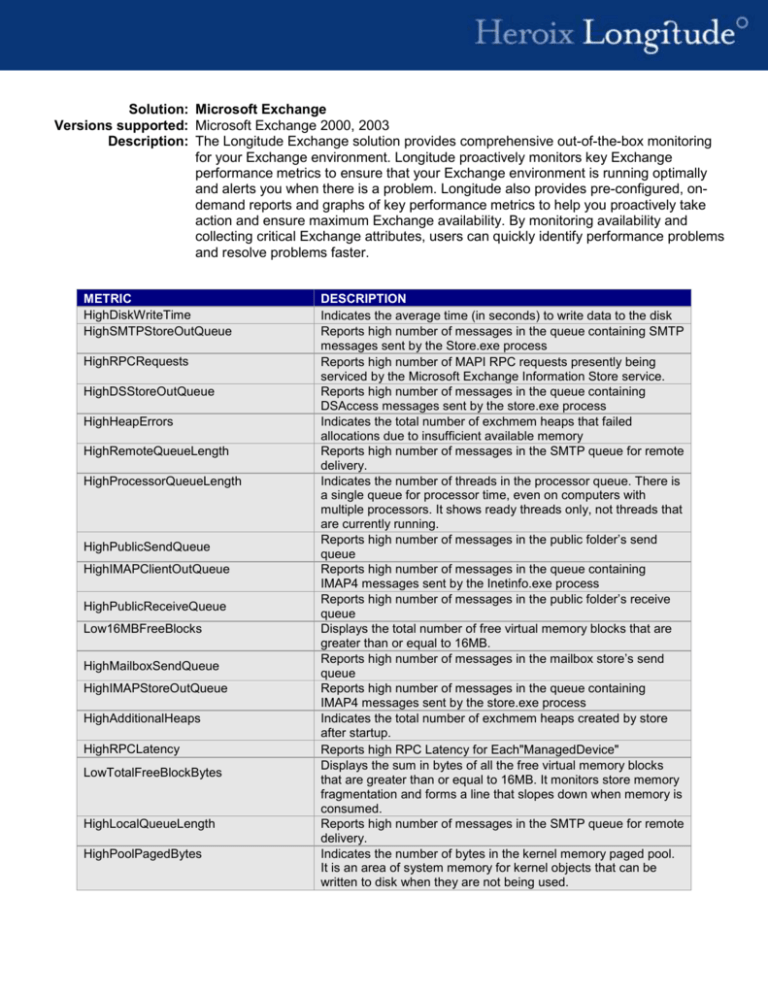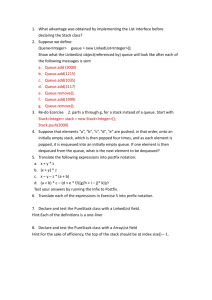
Solution: Microsoft Exchange
Versions supported: Microsoft Exchange 2000, 2003
Description: The Longitude Exchange solution provides comprehensive out-of-the-box monitoring
for your Exchange environment. Longitude proactively monitors key Exchange
performance metrics to ensure that your Exchange environment is running optimally
and alerts you when there is a problem. Longitude also provides pre-configured, ondemand reports and graphs of key performance metrics to help you proactively take
action and ensure maximum Exchange availability. By monitoring availability and
collecting critical Exchange attributes, users can quickly identify performance problems
and resolve problems faster.
METRIC
HighDiskWriteTime
HighSMTPStoreOutQueue
HighRPCRequests
HighDSStoreOutQueue
HighHeapErrors
HighRemoteQueueLength
HighProcessorQueueLength
HighPublicSendQueue
HighIMAPClientOutQueue
HighPublicReceiveQueue
Low16MBFreeBlocks
HighMailboxSendQueue
HighIMAPStoreOutQueue
HighAdditionalHeaps
HighRPCLatency
LowTotalFreeBlockBytes
HighLocalQueueLength
HighPoolPagedBytes
DESCRIPTION
Indicates the average time (in seconds) to write data to the disk
Reports high number of messages in the queue containing SMTP
messages sent by the Store.exe process
Reports high number of MAPI RPC requests presently being
serviced by the Microsoft Exchange Information Store service.
Reports high number of messages in the queue containing
DSAccess messages sent by the store.exe process
Indicates the total number of exchmem heaps that failed
allocations due to insufficient available memory
Reports high number of messages in the SMTP queue for remote
delivery.
Indicates the number of threads in the processor queue. There is
a single queue for processor time, even on computers with
multiple processors. It shows ready threads only, not threads that
are currently running.
Reports high number of messages in the public folder’s send
queue
Reports high number of messages in the queue containing
IMAP4 messages sent by the Inetinfo.exe process
Reports high number of messages in the public folder’s receive
queue
Displays the total number of free virtual memory blocks that are
greater than or equal to 16MB.
Reports high number of messages in the mailbox store’s send
queue
Reports high number of messages in the queue containing
IMAP4 messages sent by the store.exe process
Indicates the total number of exchmem heaps created by store
after startup.
Reports high RPC Latency for Each"ManagedDevice"
Displays the sum in bytes of all the free virtual memory blocks
that are greater than or equal to 16MB. It monitors store memory
fragmentation and forms a line that slopes down when memory is
consumed.
Reports high number of messages in the SMTP queue for remote
delivery.
Indicates the number of bytes in the kernel memory paged pool.
It is an area of system memory for kernel objects that can be
written to disk when they are not being used.
HighNNTPClientOutQueue
HighMemoryErrors
HighPoolNonPagedBytes
HighDiskReadTime
HighPOPClientOutQueue
HighDAVClientOutQueue
HighDAVClientOutQueue
DomainReceivedExcessMail
DomainSendingExcessMail
FolderTooMuchStorage
FolderTooManyMessages
HighNNTPStoreOutQueue
HighSMTPClientOutQueue
HighMailboxReceiveQueue
HighNetworkPacketErrors
InternetMailConnectorReceivedExcess
Mail
InternetMailConnectorSentExcessMail
LowAvailableMemory
LowFreePageTableEntries
LowVMLargestBlock
LowTotalFreeBlocks
MailboxTooManyMessages
MailboxTooMuchStorage
ServerSendingExcessMail
ServiceDown
ServerReceivedExcessMail
SiteReceivedExcessMail
Reports high number of messages in the queue containing NNTP
messages sent by the Inetinfo.exe process
Indicates the total number of exchmem allocations that could not
satisfied by available memory.
Indicates the number of bytes in the kernel memory nonpaged
pool. It is an area of system memory that must remain in physical
memory as long as the objects are allocated.
Indicates the average time (in seconds) to read data from the
disk
Reports high number of messages in the queue containing POP3
messages sent by the Inetinfo.exe process
Reports high number of messages in the queue containing
WebDAV messages sent by the Inetinfo.exe process
Compresses data tables and removes old events.
Reports when one or more domains have received too much email, measured by either messages or bytes.
Reports when one or more domains have sent too much e-mail,
measured by either messages or bytes.
Reports when there is too much storage
Reports when there are too many messages
Reports high number of messages in the queue containing NNTP
messages sent by the Store.exe process
Reports high number of messages in the queue containing SMTP
messages sent by the Inetinfo.exe process
Reports high number of messages in the mailbox store’s receive
queue
Indicates the number of outbound network packets that could not
be transmitted because of errors.
Reports when the Internet Mail Connector has received too much
e-mail, measured by either messages or bytes.
Reports when the Internet Mail Connector has sent too much email, measured by either messages or bytes.
Indicates the amount of physical memory (in MB) immediately
available for allocation to a process or for system use
Indicates the number of system page table entries that are
available. The kernel drivers use system page table entries for
holding I/O and driver data in kernel memory.
Displays the size (in bytes) of the largest free block of virtual
memory.
Displays the total number of free virtual memory blocks
regardless of size. This is used to measure the degree to which
available virtual memory is being fragmented.
Reports when there are too many messages
Reports when there is too much storage
Reports when one or more servers have sent too much e-mail,
measured by either messages or bytes.
Reports when the Exchange service is down
Reports when one or more servers have received too much email, measured by either messages or bytes.
Reports when one or more sites have received too much e-mail,
measured by either messages or bytes.
SiteSendingExcessMail
UserReceivedExcessMail
UserSendingExcessMail
LowPageRate
HighDSClientOutQueue
HighProcessorPct
HighCategorizerQueueLength
HighDAVStoreOutQueue
HighPOPStoreOutQueue
Reports when one or more sites have sent too much e-mail,
measured by either messages or bytes.
Reports when one or more users have received too much e-mail,
measured by either messages or bytes.
Reports when one or more users have sent too much e-mail,
measured by either messages or bytes.
Indicates the rate at which pages are read from or written to disk
to resolve hard page faults. This counter is a primary indicator of
the types of faults that cause system-wide delays.
Reports high number of messages in the queue containing
DSAccess messages sent by the Inetinfo.exe process
Indicates the percentage of time the processor is running nonidle threads.
Reports high number of messages in the SMTP queue for DS
attribute searches
Reports high number of messages in the queue containing
WebDAV messages sent by the store.exe process
Reports high number of messages in the queue containing POP3
messages sent by the Store.exe process
Telephone: 978 287 4855
email: info@itcsoftware.com
URL: www.itcsoftware.com
Features and support may vary by platform. ITC believes that the information in this document is accurate as of its publication date;
such information is subject to change without notice. ITC is not responsible for any inadvertent errors. Heroix, the Heroix logo, and
Heroix Longitude are registered trademarks. All other trademarks are property of their respective owners. © 2005 ITC Software. All
rights reserved.






